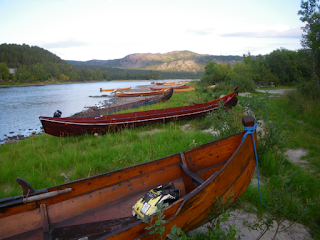The next day we retraced our steps, stopping for coffee and wifi after taking the tunnel over to Vardo. Highlights of the trip were sighting six sea eagles
and a carcass of a dead seal on a beach (not all at the same time). After returning to the head of Varangerfjord, we headed west, stopping at a campsite in Kunis. This is the second time we've arrived at a campsite only to find you have to call a telephone number to register. Here the bathrooms were locked, so we couldn't take a chance that someone would show up later and take our money. So we just turned down the next road we found and wound up at a fishing access point on the Storelva River. There were several caravans camped here and even an outhouse. After setting up our tent, we walked down along the Storelva to its mouth on the Laksefjord. The sun came out for the first time all day, but with the wind the air cooled quickly and we were early to bed.
Walking along the Storelva with the fjord in the distance
The next day we continued driving east and south, stopping at Stabburnes National Park to check out the visitor Centre and take a one hour walk out to the point on the fjord.
The vegetation is mostly crowberry, but also blueberry and another blue berry I don't recognise (edible, but not as tasty as the blueberries).
Here we saw the bird of the day, the redshank.
We are camped tonight at Alta, the largest town we have seen in a wild, at a relatively urban campsite, crammed into a small lawn area with a number of bicyclists.
Again we walked down along the river, the Altaelva. Our campsite is the smallest of three campsites all on the same road. There were several fishermen on the river and the banks were full of the traditional Sami riverboats, beautiful.
So beautiful in fact, they're worth another photo:
Lastly, a new feature, the superlative of the day:
The world's most northerly pine tree, or at least the one conveniently close to the road in the most northerly pine forest in the world -
And, bonus bird photo,
this beautiful whooper swan









I'm guessing Vaccinium uliginosum, the bog blueberry or bilberry as they're known in Europe, which gets more common to the north and isn't as tasty as the usual blueberry/bilberry (Vaccinium myrtillus)
ReplyDeleteGreat boats! Too bad those Europeans don't provide tables at their campsites, and the grass is always so dewy, but hopefully they have the kitchen shelter with stove and sink. And hot showers.